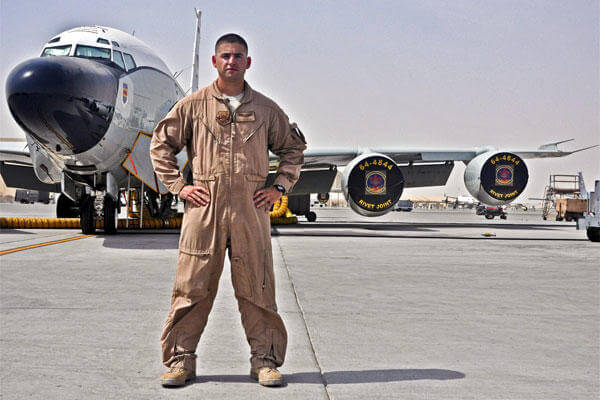SOUTHWEST ASIA -- Seven deployments in five years is a feat not many Airmen can claim.
Serving as a career enlisted aviator on the RC-135 Rivet Joint, Staff Sgt. Chris has spent nearly 735 days deployed flying more than 2,000 hours with more than 400 combat sorties.
The Nashville, Tenn., native joined the military in 2006, following in the footsteps of his grandfather, who was an Army artilleryman during the Korean War. After two years of technical training as a linguist, he was assigned to his first operational flying squadron at Offutt Air Force Base, Neb.
Since the beginning of his operational career, Chris said, "I haven't stopped deploying."
And he couldn't be closer to the truth, as he recently served a tour here at the 379th Air Expeditionary Wing.
While deployed, it was not uncommon for Chris to fly daily operational sorties over extended periods of time. The enlisted aviator flew and deployed often because of his unique ability as a linguist on the RC-135 Rivet Joint. Unlike many career fields, linguists are unique in the fact that their job on the Rivet Joint can only be accomplished while deployed. For this reason, Airmen like him continuously rotate in and out of the U.S. Central Command area of responsibility.
"Having a chance to do our job and knowing that it matters, makes the deployments easier to manage," Chris said. "It's extremely rewarding to know that we're providing support to our ground troops that helps ensure their safety and successful completion of their mission."
Linguist's unique capabilities allow them to directly support coalition forces by providing an airborne scout, increasing their situational awareness and in turn enhancing their capability to complete the mission. Because their career field is in high demand, linguists see a lot of deployment time, and not necessarily on a systematic basis.
"We don't fit into a normal (Air Expeditionary Force) deployment cycle," he said.
The linguists are enablers, and as such, they deploy more frequently and are away from home quite a bit, Chris said.
Quite a bit may be considered an understatement. In his just five years of operational service, Chris has deployed to both Iraq and Afghanistan, missing four of those five Christmases at home. This is no easy feat, but is particularly hard for someone who has been married his whole career. Together with his wife and son, they have endured deployment after deployment.
"Being a husband and a father certainly adds to the layers of responsibility we shoulder in the deployed environment," Chris said.
Through the challenges, however, his reward has been the many opportunities he has had including flying on board 10 distinctly different airframes, from the Rivet Joint to the Cessna 337 Sky Master Vietnam era relic.
As a young Airman, Chris had many responsibilities, operating often with a small crew in remote areas throughout the AOR. He and his team were required to schedule their own sorties, maintain their own equipment and track their flight information as aviation resource managers were not available in many locations. The responsibility he and others carried, although sobering, brought with it a great sense of pride and accomplishment for he and his team, Chris said.
Despite overwhelming responsibilities and a high operations tempo, the mission satisfaction and professionalism among the individuals with whom he worked made the time worthwhile, Chris said.
With his experience, opportunities and background Chris would have the right to boast of his accomplishments and revel in his war stories. But not this guy -- apart from being exceptionally grateful for the opportunities he's had, he also is appreciative of those serving with him.
"I am incredibly humbled at the opportunities I've had to serve my country and do it in a meaningful way," Chris said. "I've been even more humbled to have had the chance to work with a huge swath of members from other services, to see what they do, and to understand my place in the big picture."
The satisfaction of participating in a mission that he understands and believes in, has kept him going, and not only that, it's kept U.S. and coalition war fighters on the ground going for five years and counting.
(Editor's note: Last names have been omitted to protect the operators.)






























